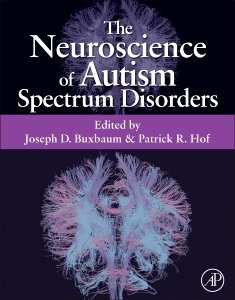Description
The Neuroscience of Autism Spectrum Disorders
Coordinators: Buxbaum Joseph D., Hof Patrick R.
Language: English
Subject for The Neuroscience of Autism Spectrum Disorders:
496 p. · 21.4x27.6 cm · Hardback
Description
/li>Contents
/li>Readership
/li>Biography
/li>Comment
/li>
Autism is no longer considered a rare disease, and the Center for Disease Control now estimates that upwards of 730,000 children in the US struggle with this isolating brain disorder. New research is leading to greater understanding of and ability to treat the disorder at an earlier age. It is hoped that further genetic and imaging studies will lead to biologically based diagnostic techniques that could help speed detection and allow early, more effective intervention.
Edited by two leaders in the field, this volume offers a current survey and synthesis of the most important findings of the neuroscience behind autism of the past 20 years. With chapters authored by experts in each topic, the volume explores etiology, neuropathology, imaging, and pathways/models. Offering a broad background of ASDs with a unique focus on neurobiology, the volume offers more than the others on the market with a strictly clinical focus or a single authored perspective that fails to offer expert, comprehensive coverage. Researchers and graduate students alike with an interest in developmental disorders and autism will benefit, as will autism specialists across psychology and medicine looking to expand their expertise.
Section 1: Autism Spectrum Disorders1.1 Epidemiology of autism spectrum disorders; 1.2 The behavioral manifestations of autism spectrum disorders; 1.3 Early manifestations of autism spectrum disorders; 1.4 Asperger Syndrome and Its Relationship to Autism Spectrum Disorders; 1.5 Behavioral and Psychosocial Interventions for Individuals with ASD; 1.6 Current Trends in the Pharmacological Treatment of Autism Spectrum Disorders; 1.7 Novel therapeutics in autism spectrum disorders
Section 2: Etiology of Autism Spectrum Disorders2.1 Medical genetics and autism spectrum disorders; 2.2 Copy Number Variation in Autism Spectrum Disorders; 2.3 Common genetic variants in autism spectrum disorders; 2.4 Next-Generation Sequencing for Gene and Pathway Discovery and Analysis in Autism Spectrum Disorders; 2.5 Mitochondria and Autism Spectrum Disorders; 2.6 Parental and perinatal risk factors in ASDs; 2.7 The Environment in autism spectrum disorders; 2.8 Hormonal influences in typical development: Implications for autism; 2.9 Immune abnormalities and autism spectrum disorders
Section 3: Brain Imaging and Neuropatholgy of Autism Spectrum Disorders3.1 Structural and functional MRI studies of autism spectrum disorders; 3.2 DTI and tractography in the autistic brain; 3.3 Attentional network deficits in autism spectrum disorders; 3.4 The cerebellum in autism spectrum disorders; 3.5 The amygdala in autism spectrum disorders; 3.6 Discrete cortical neuropathology in autism spectrum disorders; 3.7 The minicolumnopathy of autism spectrum disorders; 3.8 Inhibitory and excitatory systems in autism spectrum disorders; 3.9 Clinicopathological Stratification of Idiopathic Autism and Autism Associated with 15q11.2-q13 Duplications
Section 4: Model Systems and Pathways in Autism Spectrum Disorders4.1 Mouse behavioral models for autism spectrum disorders; 4.2 Nonhuman primate models for autism spectrum disorders; 4.3 Inducible pluripotent stem cells in ASDs; 4.4 A 15q11-q13 duplication mouse model for autism spectrum disorders; 4.5 Fragile X syndrome and autism spectrum disorders; 4.6 MECP2 and autism spectrum disorders; 4.7 SHANK2 and SHANK3 Mutations Implicate Glutamate Signaling Abnormalities in Autism Spectrum Disorders; 4.8 PI3K signaling and miRNA regulation in autism spectrum disorders; 4.9 Getting from 1000 genes to a triad of symptoms: The emerging role of systems biology in autism spectrum disorders
Dr. Joseph Buxbaum is a world-renowned molecular geneticist who has been intimately affiliated with the Seaver Autism Center since joining the faculty at Mount Sinai in 1997. Dr. Buxbaum was recruited in part to establish a molecular genetics program in autism spectrum conditions within Mount Sinai. As such, he was the Director of Molecular Genetics in the Seaver Autism Center for seven years and took over Directorship of the Seaver Autism Center itself in 2008. Dr. Buxbaum has focused on understanding the molecular and genetic basis of autism spectrum conditions, which will allow for a better understanding of what causes them, leading to the development of novel therapeutics for the negative aspects of these disorders.
Additionally, Dr. Buxbaum heads the Laboratory of Molecular Neuropsychiatry, which has taken the findings of the causes of autism and translated them into animal models where therapeutic approaches can be evaluated. In this context, Dr. Buxbaum has established the Autism Model Systems Initiative, which makes use of multiple experimental systems to develop and evaluate novel therapeutics in autism spectrum conditions.
Dr. Buxbaum has taken the lead in collaborations with multiple independent sites to ensure that the best science in the service of the families is carried out. Dr. Buxbaum is a lead investigator in the Autism Genetics Consortium, the Autism Genome Project, and the Autism Case Control Cohort, and is a part of the Psychiatric Genetics Consortium. These large Consortia have the benefit of advancing the best science at the fastest pace.
As the founder and co-leader of the Autism Sequencing Consortium, Dr. Buxbaum is part of an international group of scientists who share autism samples, data, and ideas in order to accelerate our understanding of the causes and treatments of autism.
Dr. Buxbaum, the G. Harold and Leila Y. Mathers Professor, has received numerous awards for his research. He has received recognition f
- Uniquely explores ASDs from a neurobiological angle, looking to uncover the molecular/cellular basis rather than to merely catalog the commonly used behavioral interventions
- Comprehensive coverage synthesizes widely dispersed research, serving as one-stop shopping for neurodevelopmental disorder researchers and autism specialists
- Edited work with chapters authored by leaders in the field around the globe – the broadest, most expert coverage available




